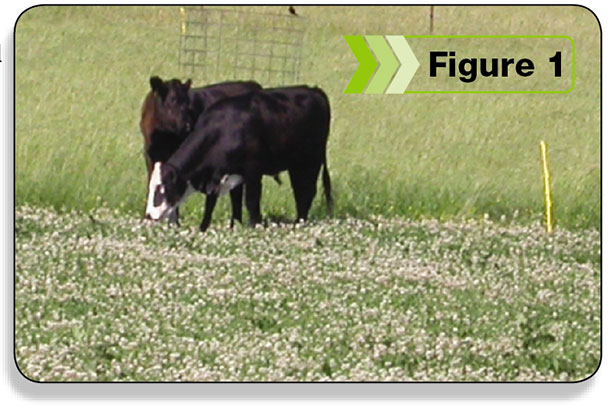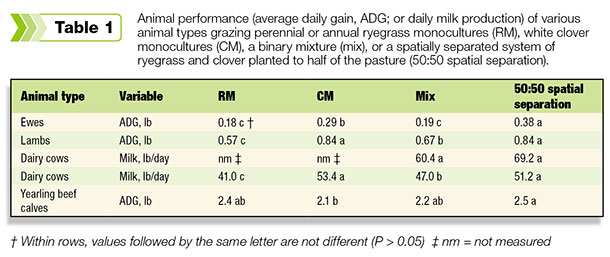To ensure sustainability and protect the earth’s resources for future generations, agricultural management should minimize any negative impact on the environment and, importantly, not deplete soil resources.
Ruminant livestock are critical to meeting the challenge of alleviating potential food shortage and ensuring sustainability because of their ability to convert cellulosic feedstuffs into high-value meat and milk products.
Highly integrated crop and livestock systems are expected to more efficiently utilize natural resources, exploit natural pest control processes, reduce nutrient losses and associated environmental risks and improve soil quality and productivity. Thus, soil health, sustainability and ecosystems are inextricably and integrally linked.
Ecosystem services
Ecosystem benefits are difficult to value monetarily but have intrinsic value of how they support our health and economy. Some of the benefits provided by pasture-based livestock systems that are considered ecosystem-good include clean air, water and soil; diverse plant and animal communities; and wildlife habitat.
Through agricultural production, the soil can provide multiple services including: food, feed, fiber, and fuel production; carbon storage, erosion control, nutrient cycling and water infiltration and storage.
Soil quality/health
Soil quality is defined by the Soil Science Society of America as “the capacity of a specific kind of soil to function, within natural or managed ecosystem boundaries, to sustain plant and animal productivity, maintain or enhance water and air quality, and promote plant and animal health and habitation.”
The term “soil health” is preferred by some because it portrays the soil as a vital living, dynamic system whose functions are mediated by a diversity of living organisms that require management and conservation. Maintaining or improving soil health requires management to increase organic matter and improve microbial activity.
Management practices that help to accomplish this include: disturbing the soil as little as possible, adding organic matter, growing diverse species of plants, eliminating practices that cause salinization and keeping soil covered at all times.
Potential benefit of legumes in pasture
Inclusion of forage legumes in pastures has positive effects on pasture outputs and on the environment. Major benefits include contributing nitrogen (N) to grasslands through N2 fixation and providing high-quality forage for animal production. Nitrogen fertilizer represents a major variable input cost. Legumes are able to provide a substantial amount of N to the pasture system.
Ruminants that graze forage legumes, compared with grasses, generally are more productive. Although the benefits of forage legumes are well documented, their widespread adoption in mixed pastures remains elusive because selective grazing of desired species has led to lack of persistence.
Typically, legumes in pastures are grown in mixtures with grasses or as monocultures. In mixed pasture communities, spatial variability and selective grazing introduce inefficiencies in pasture-based production systems. These include increased expenditure of energy associated with an increase in foraging costs, and an increase in grazing duration required to meet animal requirements.
Selective grazing of the preferred component within a pasture mixture, often the legume, can decrease the presence of that component in the pasture, because the preferred species must compete for growth resources against the other species that are not incurring the same defoliation costs.
Achieving management goals in mixed legume-grass swards is not a trivial exercise. It is well documented that animal intake of the legume is greater than that of grass, and that the nutritive value of legumes exceeds that of grass, often by a wide margin. This leads to the notion that a high proportion of legume is desirable in mixed pastures.
Because of grazing selectivity, desired proportions of legumes in mixed pastures are difficult to maintain. Worldwide, this difficulty has been considered the premier reason for lack of widespread adoption of legume-grass mixtures in pastures, although the benefits that can be accrued from such systems are well known.
An alternative approach is warranted
Chapman et al. suggested that a system of spatial separation of monoculture grass and legume within the same paddock but not in mixture (Figure 1 photo) allow for management that addresses species-specific constraints, especially weed control and soil fertility.

Such a system offers opportunity for:
- Animals to select a diet to match their preference
- Overcome feed intake constraints (e.g., rumen ammonia accumulation) associated with pure legume diets
- Has potential to support more animals per unit area than legume monoculture pastures
- Interspecific competition between grass and legume is eliminated and a stable pasture composition can be met
- N fertilizer application and herbicide can be targeted
Research in Europe, New Zealand and Australia, and our own research at Raymond, Mississippi using annual ryegrass and white clover demonstrated that performance of animals grazing spatially separated monocultures of grass and legume within the same paddock was sometimes similar to and often better than that of animals grazing monoculture legumes, and generally was superior to performance of animals grazing mixed legume-grass or monoculture grass pastures (Table 1).
Click here or on the image above to view it at full size in a new window. (PDF, 31.7KB)
Potential benefits
There is potential for economic benefits because of reduced pasture establishment and input requirements. For example, in a white clover and annual ryegrass spatially separated system, the clover does not have to be re-planted every year for a few years and only half the pasture requires N fertilizer application. Additionally, legumes potentially extend the grazing season and can reduce the need for earlier additional pasture or feed.
In terms of ecosystem benefits, soil organic matter and soil erosion is minimized through year-round ground cover and reduced tillage on at least half of the pasture. This helps maintain soil carbon and N and increase protective cover. Also, there is recycling of plant and animal manures.
Balanced production and environmental stewardship is accomplished through the conservation and integrated management systems that optimize tillage and use of chemical, synchronizing fertilizer application with crop needs and nutrient recycling.
Additionally, there is better use of renewable resources through relying less on fossil fuels and petrochemicals and depending more on biodiversity through legumes (N fixation) and crop rotations. Grass and legume could be grown alternately in rotation, that is, grass planted where legume was and vice versa, so that the newly planted grass can benefit from N buildup in the paddock that was previously legume. FG
Bisoondat Macoon is an associate research professor with Mississippi State University. Email Bisoondat Maccon.
References omitted due to space but are available upon request. Click here to email an editor.








